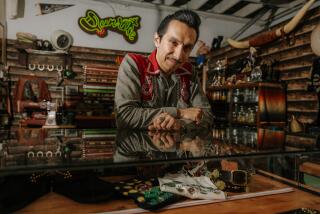Learning From the Master
Nearly 40 years ago, while still a teenager, Hutton Wilkinson became entranced by the fairy-tale world of designer Tony Duquette. As he was reading an article in the Los Angeles Times, his eyes fell upon the fantastical interiors of Duquette’s studio-residence on North Robertson Boulevard. In one glorious photograph, Duquette was cloaked in brilliant red cardinal’s robes, seated on a stage, under a golden sunburst and flanked by nacre-coated obelisks. He was, as he termed it, a “do-it-yourself De Medici.”
At first, Wilkinson, the son of a Hancock Park architect, tried to meet Duquette the respectable way--getting someone to introduce them. When that didn’t work, he found out where the designer lived and climbed into his yard several times, just to look through the windows upon wonderland. “You’d peer into the house,” Wilkinson, 45, begins, “and see the chandeliers, the 18th century Austrian ceiling, the Gobelin tapestry, the Venetian paintings, and then through the next set of doors, glass cabinets full of treasure.”
The young Wilkinson was chased off the property, but he was more determined than ever to enter Duquette’s universe. One day, he heard that the designer was seeking volunteers, and he became an unpaid apprentice for two years. Finally, the boss decided to give the young man a salary, and Wilkinson stayed on for another three years before starting his own business as a decorator. Although Duquette was not a great teacher, Wilkinson admits, he introduced the apprentice to a lifestyle, a vision.
For three decades, Wilkinson collaborated, socialized and traveled with Duquette. Six years ago they became partners in a line of jewelry. After Duquette died in 1999 at age 85, his onetime apprentice was named executor of the estate.
In that role, Wilkinson is the keeper of the Duquette legacy and is overseeing next week’s event, called “the largest house sale in history.” Some 8,000 items, consisting primarily of things Duquette collected--prints, paintings, textiles and furnishings--as well as a limited number of original Duquette creations, including eight spectacular pieces of jewelry--are going on the auction block at Christie’s. They have an estimated total value of $1.8 million to $2.6 million.
The sale is so large that the preview this weekend and the three-day sale, which begins Monday, are being mounted at the Barker Hangar at the Santa Monica Air Center. Proceeds will go to the Duquette Foundation and friends. And, of course, Wilkinson says, “we have to pay the taxes!”
A native Angeleno, Duquette started out arranging seasonal displays for Bullock’s department store and moonlighting for other designers. Then in 1940 he came to the attention of Elsie de Wolfe, then reigning doyenne of decorating. She was so impressed by a sideboard he decorated for her that she took Duquette under her wing and introduced him to both Hollywood and European royalty. For the next 50 years, he designed interiors for the likes of Doris Duke, Norton Simon and Elizabeth Arden, sets for musicals, operas and movies (including “Kismet” and a segment of “Can-Can”), and jewelry for the duchess of Windsor and, more recently, his neighbor Sharon Stone.
Wilkinson takes a reporter on a tour through Dawnridge, Duquette’s Beverly Hills abode, one of his many residences. A natural and enthusiastic raconteur, he is clearly still enchanted by creations of the master. “Look at the detail, this is petrified in plastic, this is woven, not embroidered,” he says as he points out two screens on the landing of the house. The screens have been made by having the front and the back of a Chinese silk robe embedded into a thin sheet of plastic, and, set against the windows, the colors radiate.
Many original items have been removed for the auction, but Wilkinson has replaced them with works by Duquette and his late wife, Beegle, of which there are plenty, so that the house approaches the dense look it had before. Last year Jason Stein, specialist in charge of the Christie’s auction, visited four of the Duquette residences. He recalls that each place “was as layered as could be, really gracefully.”
How to describe the Duquette style? “It’s so unique,” Stein begins. “He was a sorcerer in his ability to mix so successfully across cultures and time periods.”
“Scavenging is what I love to do,” Duquette once said. “It’s my passion instead of drinking or gambling.” Wilkinson acknowledges that obsession. “We would travel everyplace together, the four of us [the Duquettes and the Wilkinsons],” he recalls, “and we would shop.”
He accompanied Duquette on buying trips to Asia, where his friend would walk into a shop and sweep his hand across a section and say, “Give me all those.” Several times in Bali, Bhutan and Nepal, Duquette actually announced, “I’ll buy the whole store.” And somehow, many of those items became incorporated into jewelry and furnishings he sold to others, as well as into his own homes.
What was his friend’s key philosophy? Without missing a beat, Wilkinson says, “More is more, as opposed to less is more.” He laughs. “A little too much is just enough for me!”
*
The Duquette Collections, preview March 9-11 (9 a.m. to 5 p.m.), auction: March 12-14 (10 a.m. and 2 p.m. sessions) at the Barker Hangar, 3021 Airport Ave., Santa Monica Air Center. Admission by catalog only.






